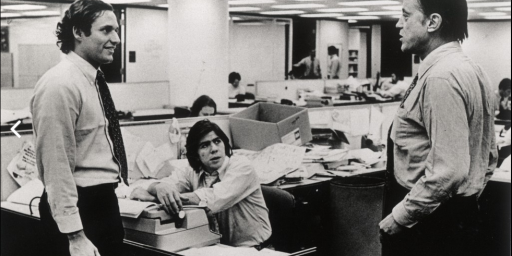Al Neuharth, Founder of USA Today, Dies At 89
The man who changed the way Americans viewed newspapers, just before newspapers themselves began getting pushed aside by technology, has died at the age of 89.
The man who changed the way Americans viewed newspapers, just before newspapers themselves began getting pushed aside by technology, has died at the age of 89:
Al Neuharth, the brash and blustery media mogul who built the Gannett Company into a communications Leviathan and created USA Today, for years America’s best-selling newspaper, died on Friday at his home in Cocoa Beach, Fla. He was 89.
USA Today announced his death. Family members said the cause was complications of a recent fall.
Mr. Neuharth’s influence on American journalism extended well beyond the 93 daily newspapers he amassed for Gannett. USA Today’s pioneering use of bright colors and bite-size articles in the early 1980s was mimicked by newspapers across the country seeking to compete with television. His business model, characterized by stripped-down costs and generous margins, reshaped the industry, tilting the balance between profits and public service and turning Gannett into a darling of Wall Street.
Mr. Neuharth’s admirers applauded him for rethinking the American newspaper and streamlining the business in a way that would make print media more nimble and competitive in the Internet age.
“Neuharth’s innovations had a revolutionary impact,” said Bill Kovach, former editor of The Atlanta Journal-Constitution and founding chairman of the Committee of Concerned Journalists. “Virtually no newspaper in the country, nor many around the world, have not been deeply affected by USA Today in terms of look, color, graphics and brevity.”
But his critics said the cost-cutting he championed was draconian and would only dumb down journalism and hasten the industry’s decline. They mocked USA Today as “McPaper” and said Mr. Neuharth’s editorial approach — emphasizing what readers wanted over what editors thought was important — resulted in a profusion of fluff.
Yet Mr. Neuharth’s emphasis on lifestyle coverage was also credited with helping to broaden the definition of news, to include cultural trends and health and consumer issues. “We give the readers what they want because we are in the business of selling news,” he told The New York Times in 1979. “If we meet the wants of an audience in a community, as we try to, successfully, then we can also give readers a percentage of what they need. But that isn’t what sells.”
In an industry long dominated by white men, Mr. Neuharth led the way in the hiring and promotion of women and minorities, tying compensation to hiring goals. By 1988 the proportion of minorities in Gannett newsrooms was 47 percent higher than the national average. Women accounted for nearly 40 percent of the company’s managers, professionals, technicians and sales agents and an unheard-of quarter of its newspaper publishers.
As Gannett’s chairman from 1973 to 1989, Mr. Neuharth transformed a regional group of mostly small, northeastern newspapers based in Rochester into a multimedia empire comprising the nation’s largest newspaper chain, 10 television and 16 radio stations and the nation’s largest outdoor advertising company, now based in McLean, Va.
Flamboyant, egotistic and proudly Machiavellian, Mr. Neuharth relished the role of larger-than-life tycoon. Even as he squeezed newspapers to plump share prices, he lived royally, maintaining luxurious executive suites in New York and Washington and five homes around the country. He crisscrossed the world in his corporate jet and was known to ride by limousine even for just a few blocks.
With a personal style that was more Rat Pack than rumpled newspaperman, he wore designer finery only in shades of black and white; was frequently seen with a woman on his arm, three of whom he married; and favored martinis. He installed bronze busts of himself in the lobbies of the two newspapers he founded, USA Today in McLean and Florida Today in Melbourne, Fla.
He was openly contemptuous of the journalistic establishment, reserving particular scorn for Ben Bradlee of The Washington Post, a rival across the Potomac with whom he feuded publicly.
“If USA Today is a good newspaper, then I’m in the wrong business,” Mr. Bradlee once said.
Mr. Neuharth shot back: “Bradlee and I finally agree on something. He is in the wrong business.”
(…)
He made his boldest move in 1982, when he gambled Gannett’s fiscal success on the dream of a national newspaper. His goal was nothing less than to reinvent the American newspaper, and to a great extent he succeeded. USA Today featured brief articles, bright colors, bold graphics and light news. Modeled on television, it sought a market of business travelers, transplants and anyone for whom six paragraphs about the Middle East was sufficient and anything less than every last sports score was not.
His disregard for what the industry considered serious news was rooted not only in marketing but also in his conviction that his small-town, heartland sensibility made him more attuned than the East Coast elites to what Americans cared about.
“Coffeyville, Kan., Muskogee, Okla., they don’t give a damn,” he told the American Society of Newspaper Editors in 1978. “The less they hear about Washington and New York, the better they feel about it.”
The experiment nearly failed. USA Today was savaged by critics as junk-food journalism. David Hall, editor of The St. Paul Pioneer Press, said it was “like reading the radio.” Even USA Today’s editor, John Quinn, half joked that it “brought new depth to the meaning of the word shallow.” And its coverage sometimes seemed like self-parody. Plumbing American behavior for potential trends generated front-page headlines like “Men, Women: We’re Still Different” and “USA Is Eating Its Vegetables.”
Readers bought it, but advertisers did not. Financially USA Today bordered on disastrous, losing $800 million to $1 billion before breaking even more than a decade later. It was a testament to Mr. Neuharth’s determination, and his power with his board, that the newspaper survived its infancy.
Like Ted Turner, the founder of CNN, Mr. Neuharth seized the technology of the moment, satellite transmission, to turn a string of cheap, local businesses into something larger than the parts, zapping USA Today’s pages to printing plants across the country. But while CNN was immediately hailed as an idea whose time had come, few people beyond Mr. Neuharth thought that another national newspaper — to compete with The Wall Street Journal, The New York Times and The Christian Science Monitor — was either necessary or viable.
“He had a vision for USA Today, and simply by dint of will made it happen,” says Alex Jones, director of the Joan Shorenstein Center on the Press, Politics and Public Policy at Harvard. “USA Today was viewed as a fool’s mission, and it has proved to be an enduring institution, and an important one.”
USA Today did not turn a profit until 1993, four years after Mr. Neuharth had retired and after the newspaper had begun shifting to more serious, and often lengthier, news coverage, partly to counter the paper’s reputation as a lightweight but also to draw more readers and advertisers, which it did. Readers, it turned out, also wanted what they need.
USA Today, the only major daily newspaper founded since World War II, went on to become the most widely read daily newspaper in the country, though it has slipped to second behind The Wall Street Journal in total circulation when digital subscribers are included. While it has yet to win a Pulitzer, it has earned a reputation for serious reporting and found a niche as a digest of the day’s news that frequently offers more heft than the local newspaper.
Say what you will about Neuharth, but you really can’t argue with the ultimate success of his vision, even if it finally did come at just about the time that the newspaper business was peaking before what would be the decline we are living through today.






I purchased a paper from one of their unique machines on the first day of publication, September 15, 1982. 25 cents, it was. People laughed about it, but almost all papers borrowed the elements over the next 20 years.
That 1982 event turned many south Brevarders (self included) into new Orlando Sentinel subscribers. Florida Today was no better loved in its home county than USA Today is elsewhere. But good for him, he created and filled a niche for a national American tabloid.
It’s ironic the story gets lost in a Friday news dump at the end of a remarkable week.
Except for the Sports Section, USA was a waste of newsprint and colored ink.
Good day! Do you know if they make any plugins to help with SEO?
I’m trying to get my blog to rank for some targeted keywords but I’m not seeing very good success.
If you know of any please share. Cheers!